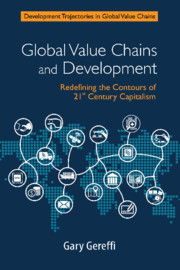Book contents
- Frontmatter
- Dedication
- Contents
- List of Tables
- List of Figures and Boxes
- Foreword
- Acknowledgments
- Sources
- 1 The Emergence of Global Value Chains: Ideas, Institutions, and Research Communities
- Part I Foundations of the Global Value Chain Framework
- Part II Expanding the Governance and Upgrading Dimensions in Global Value Chains
- Part III Policy Issues and Challenges
- Co-authors
- Index
Foreword
Published online by Cambridge University Press: 09 November 2018
- Frontmatter
- Dedication
- Contents
- List of Tables
- List of Figures and Boxes
- Foreword
- Acknowledgments
- Sources
- 1 The Emergence of Global Value Chains: Ideas, Institutions, and Research Communities
- Part I Foundations of the Global Value Chain Framework
- Part II Expanding the Governance and Upgrading Dimensions in Global Value Chains
- Part III Policy Issues and Challenges
- Co-authors
- Index
Summary
The themes covered in this book resonate with a distinction I made often between the old world of trade and the new world of trade when I was Director–General of the World Trade Organization. In the old world of trade, production was national, most trade occurred within countries, and the job of trade negotiators was to remove obstacles to trade that protected producers, such as tariffs and subsidies, so that international trade could flourish. In the new world of trade, production of both goods and services is transnational, organized in global supply chains where a product could be made in up to 10 to 12 countries, and trade increased greatly as intermediate inputs crossed borders many times in the process of making final products. This new world of trade involved value addition at every stage of the chain, and the obstacles to trade were increasingly about non-tariff barriers such as regulatory standards, consumer protection, intellectual property and data privacy, the purpose of which is to protect consumers.
A big part of my job at the WTO was to try to get people who negotiate trade agreements to make the transition from thinking about trade in traditional terms to the new realities of global supply chains. After lots of discussion with business people who were familiar with fully integrated systems of production where goods were largely produced in Asia and sold in the West, I launched the WTO's ‘Made in the World’ initiative, and shortly thereafter, we began to partner with the research unit at the OECD to elaborate ways to measure ‘trade in value added’. This helped us drive home the point that it was no longer the volume of trade per se that mattered, but rather whether and how countries were connected to increasingly pervasive global value chains.
I first learned of Gary Gereffi's pioneering work on this topic in the context of these WTO efforts to create a new narrative on global trade and development. In a couple of international conferences organized by the WTO in Geneva, such as the Global Forum on Trade Statistics in February 2011 and the Fourth Global Review of Aid for Trade on ‘Connecting to Value Chains’ in July 2013, Professor Gereffi made key presentations that illustrated how the global economy was changing and why this was relevant to policy makers.
- Type
- Chapter
- Information
- Global Value Chains and DevelopmentRedefining the Contours of 21st Century Capitalism, pp. xvii - xviiiPublisher: Cambridge University PressPrint publication year: 2018

